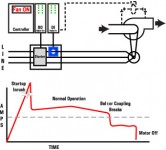In many applications, adjusting the trip point of a current monitoring sensor can be frustrating. The control cabinet must

A current sensing switch is installed in the existing control cabinet or starter enclosure, and eliminates the need for differential pressure switches, the conduit, and extra wiring to install the differential sensors. In pumping applications, the sensor can replace flow indicators and their associated wiring and piping.
be open while power is on so that the load being monitored is energized and the tight space makes getting a small screwdriver in the right position challenging. An ASM Self Calibrating Smart-Switch solves this problem by using the actual load current to set the trip point. It takes just a couple of seconds of steady running conditions before the sensor locks onto the normal current level. If the load draws more current than normal or the current drops significantly, the sensor output will open. As long as the current stays between 85 and 125% of the normal level (overload/underload models only), the sensor output will be closed. No manually setting trip points and no adjustment is needed.
ASM Series Self Calibrating Smart-Switch makes Monitoring Motor Current Loads Simple
The ASM Series Self Calibrating Smart-Switch provides the simplest way to be sure a motor is working properly. The newly designed ASM is more accurate and easier to set up than previous models. The solid-state contact is closed when the load is energized and drawing between 85 and 125% of normal current. The sensor slides or snaps over one conductor feeding the load. The contact controls the input voltage, AC or DC, to 135 volts to a controller or small relay. If the current falls below 85% of normal or increases above 125% of normal (overload/underload models only), the contact will open. One contact to alarm in over or undercurrent conditions, or both. No adjustment is needed unless the motor is changed. If the motor is replaced, calibration is very easy and within a matter of minutes, the system is back in operation.
Related Products
Monitoring Steady AC Current
- Pumps
- Fans
- Heating elements
- Conveyors
- Safety-interlocking with other loads
